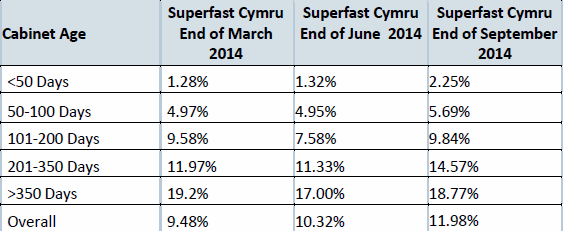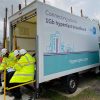UPDATE4 First BDUK Fuelled BT “Fibre Broadband” Take-up Figures Emerge
Attempts to secure information about the take-up of BTOpenreach’s “fibre broadband” (FTTC/P) services and related claw-back provisions under the Government’s Broadband Delivery UK programme are often futile (we’ve tried asking BT, BDUK and many councils without success), yet a recent Freedom of Information (FoI) request has managed to secure related information.. albeit only for Wales.
The ability to understand uptake of services supplied under the BDUK contract, which aims to make fixed line superfast broadband (24Mbps+) speeds available to 95% of the United Kingdom by 2017, is crucial in order to judge progress and asses how much benefit might be derived from the claw-back mechanism.
Advertisement
Claw-back allows money (i.e. the BDUK subsidy) to be returned and reinvested into adding further coverage once a certain percentage of take-up has been achieved. Mind you some contracts aren’t as clear, with Staffordshire’s simply saying (here) that subsidy returned via claw-back should be “returnable to public funds“.
A recent article on the FT suggested that if 50% take-up were ever achieved, across the whole of the United Kingdom, then that could be worth as much as £270 million (i.e. money available for reinvestment to improve superfast broadband coverage etc.). A number of BDUK contracts are understood to have set their claw-back level as starting at 20% take-up.
BDUK’s Claw-back Mechanism (EC State Aid Monitoring Requirements)
To facilitate exercise of the claw-back provision, the UK will oblige local bodies to impose on their suppliers a number of reporting obligations. These obligations will require regular reporting on matters such as: actual deployment; actual expenditure; and demand levels. An accounting separation will be imposed on the selected bidders within the Framework Agreement as regards the subsidized projects that will make it easier for the granting authorities to monitor the implementation of the projects as well as any excess subsidy.
According to the above description and its associated “transparency requirements“, which is all taken from a state aid decision on the BDUK framework, local authorities (i.e. county councils) should ideally be keeping track of take-up and it follows that BT should thus similarly be able to separate their commercial FTTC/P uptake from those funded via state aid.
In practice ISPreview.co.uk and others, such as Patrick Cosgrove of the Shropshire and Marches Campaign, have asked multiple councils, BT and BDUK but until recently we’ve almost never been given a clear answer. Openreach usually directed us back towards the councils, while the councils would say they didn’t hold such data and BDUK said they’d look into it but then never responded despite prompting. We did a lot of prompting.
Advertisement
In the example of Gloucestershire and Herefordshire, which jointly form the local Fastershire scheme, the excuse given via the Whatdotheyknow website was to claim that Fastershire is not subject to Freedom of Information (FoI) requests because the partnership also involves BT, a private company (here we go again). Not that it matters because asking Fastershire directly also resulted in a response claiming that no such data was held.
But the good news is that recently some data has begun to leak out, although at present the compliance on this front remains woefully inadequate. For example, at the end of September 2014 we understand that Shropshire was running a BDUK specific take-up of 8% and last night Patrick Cosgrove contacted ISPreview.co.uk to say that he’d also managed to squeeze some detailed data from the scheme in Wales.
Mr Cosgrove asked for the percentage take-up of superfast broadband where green cabinets (or Exchange Only lines) have been upgraded with fibre-optic cable as part of the BDUK-funded rural broadband project for the three most recent quarter years: (January, February and March 2014 (Q1); April, May and June 2014 (Q2); and July, August and September 2014 (Q3). Amazingly he got the following in reply.

The “Cabinet Age” is likely a reference to how up-take changes over time after the cabinet is first installed / upgraded, which will also vary depending upon how many premises have been upgraded within a given timeframe etc. It’s a useful indication of where things are heading, which is despite the overall figure for September 2014 sitting at only 11.98% (up from 9.48% in Q1 2014). The roll-out in Wales, much like most of the rest of the UK, is of course continuing and so this does have an impact. Take note that the project in Wales recently reported making the “fibre broadband” service available to 276,000 premises (here).
Advertisement
Meanwhile the Broadband Delivery UK programme recently hinted at plans to launch a big advertising campaign in order to help raise awareness about the availability of the faster connectivity (here). Often people don’t even realise when their area has been upgraded or incorrectly expect to benefit by default and others still don’t understand what “fibre broadband” actually is (funnily enough.. neither does the ASA *chuckle*).
At the same time most of the work so far has focused on delivering improvements to sub-urban areas or larger towns, where many people can often already receive reasonable connections using older ADSL2+ services (i.e. it’s harder to sell FTTC to somebody happy on 10-15Mbps ADSL2+, especially if they’re paying considerably less). By contrast those in slower rural areas can easily see the appeal, but they’re often last on the upgrade list and have a considerably smaller population density (i.e. less of an influence on the overall figures).
All of those and other factors can influence take-up, which means we shouldn’t really be expecting to hit that 20% mark just yet given that most projects have only been deploying for a year or so (in some cases the roll-out has only recently started). Never the less we should all be expecting more transparency from our local authorities concerning the reporting of take-up progress, which has so far proven difficult to achieve and that’s despite its crucial relevance to the assessment of claw-back.
UPDATE 26th Nov 2014:
According to enquiries made by Patrick Cosgrove, the BDUK scheme in Dorset has so far seen take-up of 7.2%. But in fairness the practical roll-out phase for that project is still fairly young.
UPDATE 27th Nov 2014:
We thought it might be useful to note that the Government issued a sort of FAQ on the Claw-back mechanism in July 2014 (here), while the European Commission’s original state aid decision on the BDUK framework can be found HERE. Most of the industry will be familiar with these documents already but as we quote the EU’s monitoring requirement above then it’s relevant to provide the full and supporting documentation.
Separately we also thought it might be useful to reflect Staffordshire’s full position on Claw-back in their contracts, which stems from their Local Broadband Plan documentation (here).
Staffordshire’s Claw-back Approach
Under the terms of the grant contract, the supplier will be monitored for a period of seven years. If the actual investment gap is larger than £29.76m then it will be the responsibility of the supplier to absorb those extra costs – the capital grant will not be increased. However, if the actual investment gap is proven to be less than £29.76m then a clawback clause will be activated.
This is a legal requirement under State Aid law, because the value of public investment in commercial infrastructure to address market failure must be proportionate and reasonable – it is not permissible to have invested excess funds, and any excess will be returnable to public funds.
UPDATE 5th Dec 2014:
The county of Worcestershire has now reported a figure of 3.2% for the same period, although most of their premises were only covered in September 2014 and so the figure was bound to be low.
UPDATE 9th Dec 2014
Patrick has further been able to extract the take-up data for the Fastershire BDUK project, which covers the two counties of Gloucestershire and Herefordshire in England.
End of March 2014 = 7.31%
End of June 2014 = 12.22%
End of September 2014 = 13.40%
Mark is a professional technology writer, IT consultant and computer engineer from Dorset (England), he also founded ISPreview in 1999 and enjoys analysing the latest telecoms and broadband developments. Find me on X (Twitter), Mastodon, Facebook, BlueSky, Threads.net and Linkedin.
« UPD2 BT Confirm Talks to Buyback O2 UK from Telefonica or Possibly EE


















































Comments are closed